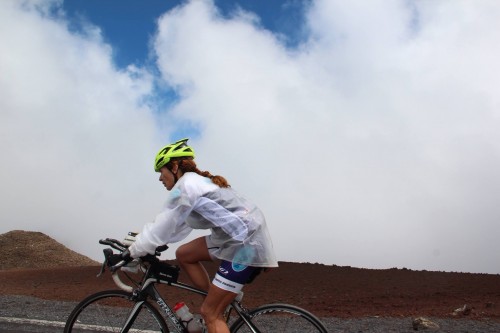
Near the top of the 10,000 foot climb, the scenery was breathtaking. And, it was a little hard to breathe.
The degree of nervousness I felt about my first time cycling from sea level to the top of Maui’s Haleakala Crater at 10,000 feet was close to what I feel before a major race. I didn’t know exactly what the day would bring, but I knew there would be times when I would have to dig deep through pain and fatigue and just keep on going. Adding to my nervousness was the fact that the last time I had done any prolonged climbing on my bike things had ended quite poorly, with severe cramping in both of my legs that caused me to fall off and lay sprawled in pain in the middle of the road. But, I was determined that I was going to make this climb and just take things as they came.
I joined the Boca Cycling Clinic in January and the Haleakala Climb on March 9 was the event we all trained for. I felt moderately prepared but not overly confident because I had missed the last two weeks of training due to a great mainland vacation.
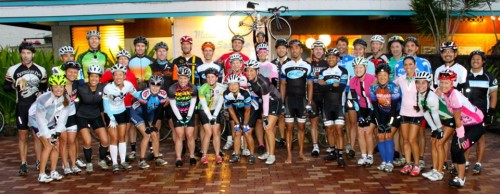
Our group of 40 riders and coaches ready to roll out of Kahalui at the break of dawn.
We all met for dinner the night before the climb to get some final tips and advice and to understand the logistics of getting 40 people and bikes up and then back down the crater. Then, at 6am on Sunday, March 9 we met at the Maui Seaside Hotel in Kahalui to prepare to roll out at 6:30. Vans were there to carry extra clothes and food for each cyclist. It was drizzling, but it seemed that the weather would improve. I put on my rain jacket to stay dry so I wouldn’t be wet and cold later in the day. I’m glad I did, because we were soon riding through consistent rain from Kahalui to Makawao where the climbing started to get more serious. With increased effort and the sun now out, I rolled up my jacket and put it in my pocket as I started to overheat. At a brief rest stop, I gave my jacket to Rick.
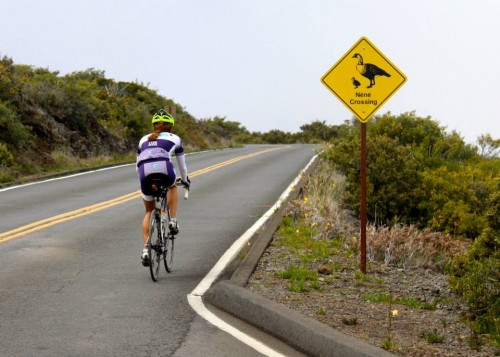
The nene goose is Hawaii’s endangered state bird. I didn’t get to see one, but I did see a beautiful pheasant.
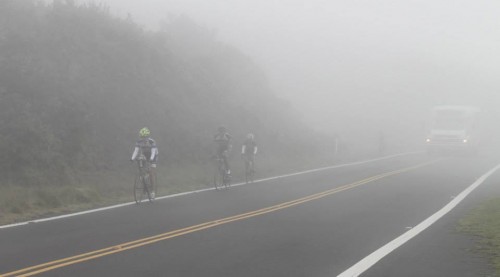
We rode into and out of rain and fog throughout the ride.
We climbed through wooded hills to grasslands to tundra-like fields and then finally into lava fields. And from sun to rain to fog to sun to fog to rain to fog and more rain. After the first rain without my jacket at about 7,000 feet, I wasn’t too cold and as I looked ahead, it seemed that the clouds were lifting. So, I didn’t get my jacket back from Rick, who was supporting me by car and taking some fantastic photos along the way. Of course, then it did rain and I got soaked. (I thought it was quite funny that I stayed dry early in the day and then was outsmarted by the weather later.) I wanted to get my jacket back from Rick, but places for him to pull off of the road were limited and where they did exist, the grade of the road was very steep and I was nervous about starting on a steep grade. So, I continued to get wetter and colder until we finally found a place to meet where I could put on my rain jacket to at least keep the wind from further chilling my wet body. I rode 42 miles from Kahalui to the summit at 10,000 feet in just about five and a half hours.
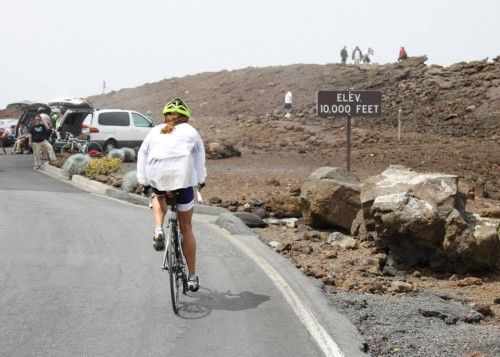
The final part of the climb is very steep and I was in and out of my saddle as I approached the finish.
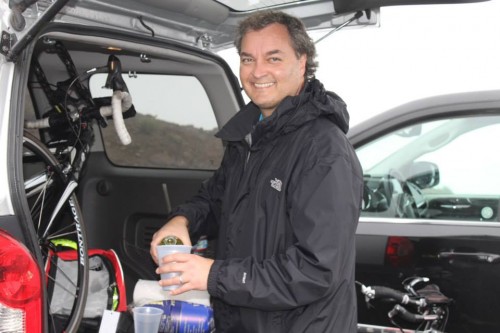
A nice reward for me awaited at the summit.
A big cheer from those already at the top, a hug from Rick, warm and dry clothes and a plastic cup filled with my favorite Savignon Blanc, greeted me at the top. I finished with a big smile on my face.
It was a fantastic day for me–I absolutely loved the experience. Maybe some of the things that worked for me might help you if you decide to tackle this ride or anything like it.
1. Training: Plenty of cycling, on hills and on the turbo trainer of course was important. I came into the training with a relatively strong base from Ironman Cozumel in December, so the eight week training period was just right. Additionally, I did kettle bell workouts 2-3 times per week, strengthening my quads, glutes and core. I have found that strength training is important for me in endurance events, and I think it becomes increasingly important as I get older.
2. Gearing: I have always had a compact crank on my bikes. As someone who continually works on improving my cadence, I find this works best for me. That means a 50/34 on the front. On my cassette, I switched out my 11/25 for an 11/28. This would give me a better ability to spin at a decent cadence up the hill rather than grinding it out and increasing the load on my muscles and the risk of cramping that goes with it. I used a lot of gears on the ride, but I spent a lot of time in my easiest gear. I reminded myself that this wasn’t a race.
3. Foam rolling: I brought my mini foam roller with me to Maui and rolled my legs out twice the day before and then again the morning of the climb. As someone who tends to cramp, this seems to help.
4. Nutrition: I ate with the climb in mind for the two days beforehand. Good food, plenty of carbs, lots of water. That morning, I had my typical pre-race half of a peanut butter and banana sandwich with coffee about 2 hours before we started. On my bike was a bottle with 500 calories of SPIZ, my tri-bottle filled with Skratch, and a Bonk Breaker and a gel in my bento box. In the car was 500 more calories of SPIZ powder, the other half of my peanut butter and banana sandwich, and another energy bar. I drank my bottle of SPIZ, all of my Skratch, another quarter of my sandwich and drank more water before getting to 7500 feet. Taking a break at the Visitors Center, I filled my tri-bottle with the rest of the SPIZ and ate my Bonk Breaker. I had been told that the higher elevation and effort might make it difficult to eat, so I thought the SPIZ would give me my best chance to get the nutrition I would need. Note that I used my tri-bottle to make it easier to take in nutrition while I was climbing. When there is a straw in my face and I don’t have to reach down to grab a bottle and then replace it, I drink more. I estimate that I took in about 1500 calories for the climb. Note that SPIZ works well for me. I’m not sure why, but different from many sports drinks, it contains protein.
5. Consistent cadence: We were given advice to “start like a chicken and finish like a rooster”. What a great way for Raul Boca to recommend that we ride conservatively and save our energy for the tough miles that would come later. I followed his advice and let a group of people I typically ride with pull out ahead. It was a challenge to my ego, but I typically do better by focusing on myself rather than worrying about what other athletes are doing. I kept a consistent cadence, smooth and steady on the flats and the climbs, shifting gears to make that possible. I came out of the saddle on portions of the steeper bits and from time to time to stretch out my legs and back. My strategy worked well in helping to avoid cramping and in finishing earlier than some who started out faster than me.
6. Clothing: The weather on Haleakala changes rapidly. And at 10,000 feet, even on a sunny day, it can be quite cold. I wore a long dri-fit running top under my bike jersey, knee-length bike shorts, arm warmers and thick socks. I didn’t have anything but fingerless gloves, so I wore those. I had a rain slicker, a heavier bike jacket and a headband and extra pair of socks at the ready. I wore gradient Rudy sunglasses that worked perfectly in all conditions. If I had planned to ride down, it would have been critical to also have full, warm gloves, headgear, and a waterproof and warm jacket. The cyclists who decided to ride down suffered freezing rain and you could actually see them shivering during their descent.
7. Attitude: Yes, at times it is hard. But the way you look at those tough times can make a big difference. No matter what, I decided that I would take the day for what it would bring and enjoy the adventure along the way. When it was hard, I told myself to “just keep pedaling” and I thanked my legs and my body for letting me tackle this adventure. And like I do when I race, I try to keep a smile on my face at all times. Perhaps it’s sometimes more like a grimace, but I think it works to help me keep a positive attitude. I truly believe that being positive and open to whatever an experience will bring makes a big difference in the outcome.
8. Support: You can probably carry all that you need to do the climb on your own. But, it would be much easier if you had support for extra clothes and food so you don’t need to carry everything. Having a buddy or others that are riding up with you makes it a lot more fun, and should you need help, it’s right there with you. Haleakala is a national park and they do not allow formal groups to ride within it, so you need to be a bit discreet if you’re doing a group ride. Note that there are no services for the last 22 miles of the climb and only one place to get water. The cell signal for me was also very weak at the top and was spotty during the upper parts of climb.
9. Altitude: Climbing from sea level to 10,000 feet means less available oxygen as you go. Add fatigue from the consistent climbing and it can be pretty hard to breath at the end. Take nice, deep breaths and try not to think too much about the altitude. Imagining the thin air isn’t going to help you one bit, so put it out of your mind and instead enjoy the breathtaking scenery. Also, make sure your nutrition and hydration aren’t making things worse.
10. Celebrate: If you are only riding up, enjoy your incredible accomplishment. I was so happy to make it up, I forgot about any of the tougher parts of the climb. If you ride down, which would be spectacular on a nice day, savor the descent as you effortlessly return to the sea.
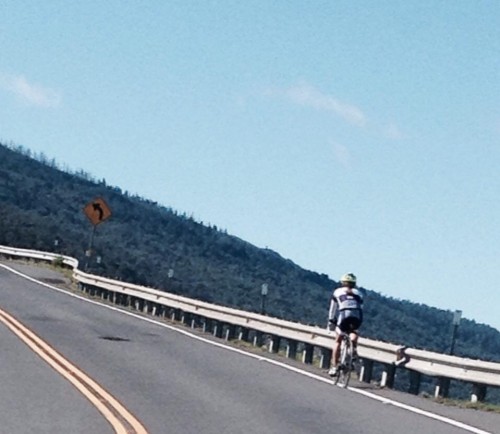
You never know what you can do until you try. And today I know that I can cycle to the top of a volcano!










Paula Bender Mar 12 , 2014 at 4:46 pm /
Super report! Just what I wanted to read. Thanks for doing this and sharing your experience. John and I both want to do this next year with Raul and Boca Hawaii. The training we get from Raul and the Boca folks has been so encouraging. I feel improvements already! Way to go, Lori! Congratulations on your Haleakala climb!
Lori Mar 12 , 2014 at 7:59 pm /
Thanks Paula! I know that you and John will enjoy this ride as much as I did.